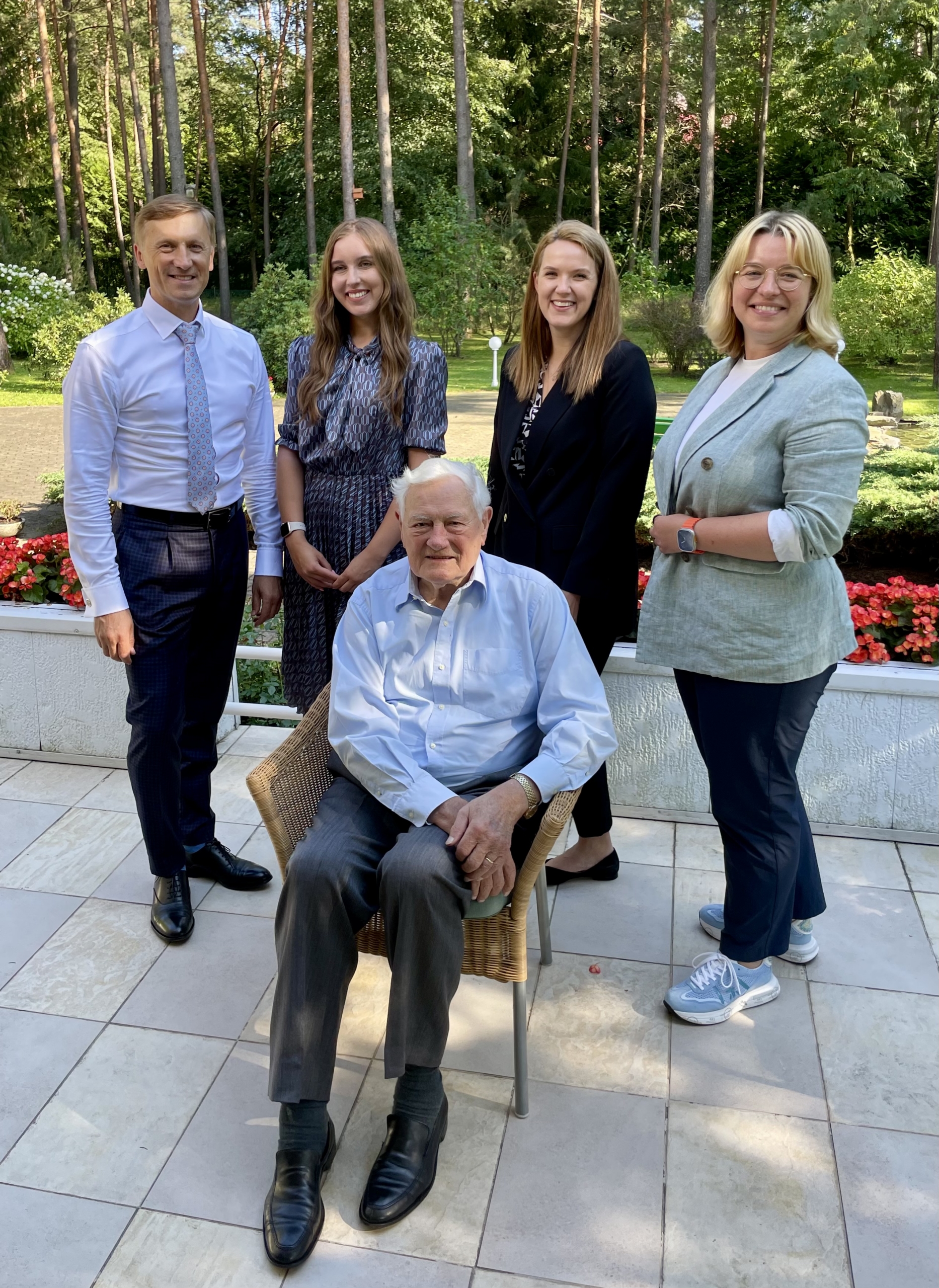When we talk about charitable foundations, we usually think first of the benefits they bring to society – supporting schools, culture, Ukraine, helping vulnerable groups or tackling climate issues. What is often forgotten is that a foundation is not just a “charity box”. It is a structure that can strengthen a family, improve reputation of a business, provide tax advantages and, most importantly, help create lasting change in society. That’s why more and more businesses and families are choosing this route – it’s a win-win for all.
Foundations bring the family together
A foundation can be set up (in different legal forms) by an individual or by a large organisation, but it is particularly important for family businesses. Experience has shown that business succession often poses many challenges – from differences of interests (sometimes children do not want to be engaged in parents’ business) to disputes among family members (usually the question what is the right way to divide the shares among the children is critical). Though foundations are usually associated with charity, their benefits for family businesses go far beyond that – it becomes a tool that helps to bring together several generations for a single purpose and ensure the continuity of the business.
This was particularly emphasised during a recent event organised by Sorainen where we had the opportunity to speak with Joseph and Lucy Kazickas – the managers of the Kazickas Family Foundation. Kazickas Family Foundation has been supporting education, culture, and social initiatives in Lithuania and among the Lithuanian diaspora abroad (mostly in USA) since its creation in 1998. During the discussion, when asked about the secret to their family unity, Joseph and Lucy Kazickas replied that first it was all thanks to Joseph’s parents – Dr. Juozas Petras Kazickas and Aleksandra Kazickienė who have always been sharing strong values, one of them being sharing itself. Thus the spouses created the foundation that unites the family members who live in different countries, have different businesses, but one common purpose – sharing the earned profits and contributing to growing prosperity in the country. As Dr. Kazickas wrote in his book Vilties kelias (Eng., The Way of Hope), the decision to establish the foundation was initially motivated by what might seem like egoistic goals – namely, the desire to bring the family together.

A photo from the event, hosted by Sorainen and The Kazickas Family Foundation, for our clients to meet Lucy and Joseph Kazickas in September 2025
By participating in the foundation’s activities, family members come together for a noble cause and there is no competition between them, as they simply have nothing to gain from it. Importantly, instilling these values at a young age ensures that family members grow with a shared sense of purpose, making it far more likely that the younger generation will continue to engage with the foundation throughout their lives. In the words of Giorgio Armani – whose passing at the start of September marked the end of an era – succession should be “organic and not a moment of rupture”, a principle perfectly reflected in the way the Kazickas family approaches their foundation’s work.
Conflict prevention
By contrast, history shows that without a shared purpose or structured framework, family businesses often face disputes over wealth and control, sometimes undermining years of carefully built unity. A few notable examples include:
- The Gucci family experienced prolonged conflicts over inheritance and company control after the founder’s death, ultimately losing control of the business to external investors. Their struggles were dramatised in the movie ‘House of Gucci’, highlighting how personal and financial disagreements can fracture even the most prominent family enterprises.
- The Hermès family faced significant tension and disputes as differing visions over ownership and management emerged among family members. After successive generations inherited shares, some family members sold portions of their stake while others sought to keep the company under family control, sparking legal battles and public disputes that reflected deep differences in vision. This situation highlighted how the complex ownership structure, designed to protect family control, could also create friction.
The effectiveness of the foundation stems from careful planning and thoughtful structuring. Clear priorities, boundaries, and direction are essential for achieving its objectives, including decisions on which organisations to support, the criteria they must meet, and how the foundation will measure its impact. While the foundation’s guidelines provide a framework, they are not rigid; exceptional cases can be considered, and it is through this collaborative process that each family member becomes a valued and engaged participant. In this way, every decision is coherent, and the foundation’s activities remain purposeful, meaningful, and unifying for the entire family.
Reputation and trust
The second benefit is that the foundation’s activities naturally enhance the reputation of the business, as well as the family behind it. When a company or well-known brand establishes a foundation, it goes beyond helping society – it communicates the values the business stands for, builds trust, and can even attract new partners. This reputational benefit is not the primary goal – it is a natural byproduct of genuinely supporting social causes. Research published in the Southeast Asia Journal of Social Sciences (So05, 2023) shows that sustained charitable efforts, known as “durative philanthropy”, strengthen reputation and consumer loyalty by demonstrating a consistent commitment to social responsibility.
The success of philanthropic initiatives depends not only on the amount of support provided but also on the focus and communication strategy. Targeted giving can naturally reflect a company’s core values. As Dr. Kazickas wrote, “a person’s worth is not measured by how much they have, but by how much they are able to give”, which perfectly captures why aligning giving with core values creates a meaningful and authentic impact. The impact is visible in real-world examples: Gucci’s Chime for Change initiative highlights women’s rights, the IKEA Foundation invests in education and climate projects, and the Kazickas Family Foundation focuses on education, reflecting the family’s long-standing values of knowledge and community development.
Strengthening employee engagement
In business organisations, sustained social responsibility has a significant impact on employee loyalty, morale, and engagement. When companies actively involve their staff in philanthropic activities – whether through volunteering programs, fundraising initiatives, or direct participation in foundation projects – employees not only feel a stronger connection to the company’s mission, but also take pride in contributing to meaningful social causes. This engagement fosters a sense of purpose beyond day-to-day tasks, increases collaboration among colleagues, and often leads to higher job satisfaction and retention.
This aspect becomes especially relevant when considering younger generations entering the workforce. As highlighted by Rūta Lapinskienė and Dominyka Venciūtė in their article “Darbdavio patrauklumas Z kartos akimis: kas svarbu renkantis darbdavį jaunajai kartai?” (Eng., Employer attractiveness in the eyes of Generation Z: what matters when choosing an employer for the younger generation), young employees often fear that staying too long in the same position may limit their opportunities for growth and development. They value a clear career trajectory, new skills, and diverse experiences. Changing jobs every 3–5 years is seen as a natural way to avoid routine and remain competitive, while staying in the same role for more than 10 years appears excessive. Longer tenure within one organization is acceptable only if it provides clear career opportunities and conditions for continuous learning.
In the long term, integrating employees into philanthropic efforts helps create a workplace culture that mirrors the company’s values and amplifies the impact of its social initiatives, making the organisation both socially responsible and internally cohesive.
Financial incentives
In Lithuania, a charity foundation can take the form of a charitable fund or an endowment fund (though other forms may also be used):
- A charitable fund (Lith. Labdaros ir paramos fondas) mainly focuses on collecting donations and redistributing them to people in need or qualifying initiatives. Donations (food, money, or goods) come from businesses, individuals, or public programs. The organisation sorts and stores what it receives to ensure safety and proper use. Then, the collected resources are distributed, either directly to people or through partner organisations.
- In contrast, an endowment fund (Lith. neliečiamąjį kapitalą valdantis fondas) creates a permanent stream of investment income, allowing donors’ contributions to “work” over the long term. Donated funds are invested into various financial instruments, and the income generated from these investments is used for the fund’s purposes. This ensures that the fund can operate and finance projects for a long time without constant fundraising (or at least some stable income).
One of the features that distinguishes an endowment fund from a regular charitable fund is the minimum capital requirement (which currently is 72,405 EUR) that can be accumulated over three years. During this period, the fund must only invest in safe financial instruments, such as deposits or government securities.
While the financial benefits of the charity are not direct profit, the advantages appear in the sense that the donor is not ‘losing out’ by giving. When donating to either a regular charity or an endowment fund, donors can benefit from tax relief. For companies in Lithuania, the qualifying donated amount can be deducted twice from their taxable profit (with restrictions on cash donations), provided the total deducted amount does not exceed the 40% taxable profit cap, calculated after subtracting exempt income, allowable and limited deductions (excluding donations and previous year tax losses) from total income. Individuals can allocate up to 1.2% of their paid personal income tax to eligible charitable organizations. The advantages appear in the sense that this does not incur any additional cost – it is redirected from the tax already paid.
Nevertheless, an endowment fund usually should offer a stronger advantage because it creates long-term impact. A regular charity fund spends donations relatively quickly to provide immediate help, such as food, clothing, or social services. An endowment fund, on the other hand, invests the donations and uses only (or largely) the income generated from those investments. This ensures that a single contribution continues to deliver benefits year after year.
In Lithuania, endowment funds remain a relatively new phenomenon, but they are becoming increasingly common. Last year, we assisted in establishing an endowment fund in Lithuania of Valdas Adamkus, former President of the Republic of Lithuania, and his late wife Alma Adamkienė, enabling their philanthropic activities to continue. This and a few other Lithuanian endowment funds (e.g. Vilnius University endowment fund) have encouraged other charity organisations to consider this form of a charity foundation.

Our Private Client team — from left to right: Laimonas Skibarka, Barbora Bernatonytė, Gerda Skirbutienė and Saulė Dagilytė — together with H.E. Mr Valdas Adamkus in 2024.


